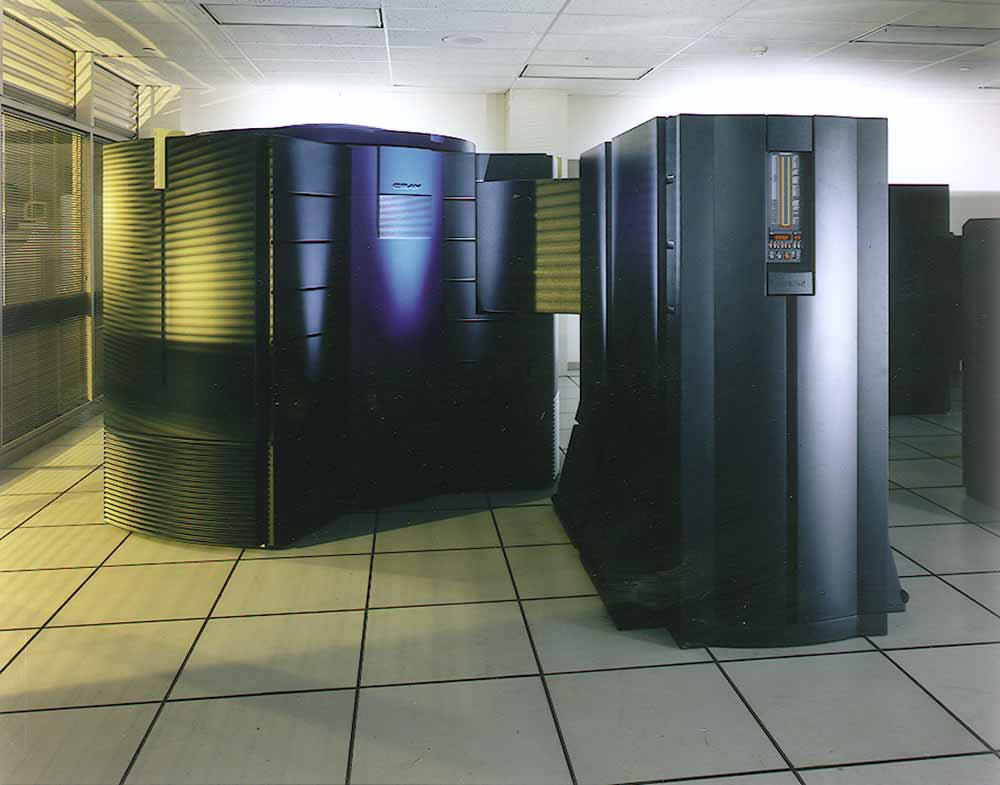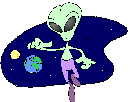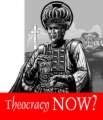In Fredric Brown's short
story "Answer," computers all across the galaxy are linked together
to create a superpowerful, conscious computer. When it is finished, it is asked
the question, "is there a God?" And the computer responds,
as it seals shut the switch with a bolt of lightning, "there is now."
Similarly, in Isaac Asimov's short story, "The Last Question,"
the computer is asked whether entropy can be reversed. The computer
puzzles over the question as the universe cools down to absolute zero,
until finally it says, "let there be light!"
superpowerful, conscious computer. When it is finished, it is asked
the question, "is there a God?" And the computer responds,
as it seals shut the switch with a bolt of lightning, "there is now."
Similarly, in Isaac Asimov's short story, "The Last Question,"
the computer is asked whether entropy can be reversed. The computer
puzzles over the question as the universe cools down to absolute zero,
until finally it says, "let there be light!"
 The Creator (1935) by Clifford Simak features a world-creating
alien and Parke Goodwin's Waiting for the Galactic Bus (1988) is
about aliens who were responsible for
The Creator (1935) by Clifford Simak features a world-creating
alien and Parke Goodwin's Waiting for the Galactic Bus (1988) is
about aliens who were responsible for breeding Homo Sapiens who have taken on the roles of God and Devil.
breeding Homo Sapiens who have taken on the roles of God and Devil.
Humans have had their delusions
of grandeur as well. In both Theodore Sturgeon's "Microcosmic
God" (1941) and Edmond Hamilton's "Fessenden's Worlds (1937)
feature scientists watching, presiding over, and controlling their tiny
universal creations. Other stories where  humans
create God or gods are The God Makers (1972) by Frank Herbert and
Lord of Light (1967) by Roger Zelazny.
humans
create God or gods are The God Makers (1972) by Frank Herbert and
Lord of Light (1967) by Roger Zelazny.
2. The second division of Holy Science Fiction includes stories that use religion as a tool of the government.
In Margaret Atwood's The Handmaid's
Tale, fundamentalist Protestantism is used to justify the subordination
of women. Keith Roberts Pavane (1968) is a collection of
linked stories set in an alternate world in which Elizabeth I was assassinated and 20th-century England,
technologically backward, remains oppressed by the Catholic Church.
In Walter Miller Jr.'s
novel A Canticle for Leibowitz (1960), after the devastation of
a nuclear war, a monastery collects and copies the books and artifacts
of science and engineering. Its library ultimately makes available
the information necessary to recreate technical civilization that once
more brings about nuclear destruction. Others
include John Campbell's "All," and Keith Robert's Kiteworld.
world in which Elizabeth I was assassinated and 20th-century England,
technologically backward, remains oppressed by the Catholic Church.
In Walter Miller Jr.'s
novel A Canticle for Leibowitz (1960), after the devastation of
a nuclear war, a monastery collects and copies the books and artifacts
of science and engineering. Its library ultimately makes available
the information necessary to recreate technical civilization that once
more brings about nuclear destruction. Others
include John Campbell's "All," and Keith Robert's Kiteworld.
3. The third division of Holy Science Fiction includes those stories that question and challenge the reality of God and the institution of religion.
 These
stories are numerous (and are scattered throughout some of the other divisions
- one good example being the aforementioned Waiting for the Galactic
Bus, 1988). In The Dawn of All (1911) by Robert Hugh
Benson, the reader witnesses a utopian world where people have renounced
materialism, humanism, socialism and Protestantism. In Guy Thorne's
When it Was Dark (1904) rationalism is employed to discredit the
Christian faith.
These
stories are numerous (and are scattered throughout some of the other divisions
- one good example being the aforementioned Waiting for the Galactic
Bus, 1988). In The Dawn of All (1911) by Robert Hugh
Benson, the reader witnesses a utopian world where people have renounced
materialism, humanism, socialism and Protestantism. In Guy Thorne's
When it Was Dark (1904) rationalism is employed to discredit the
Christian faith.